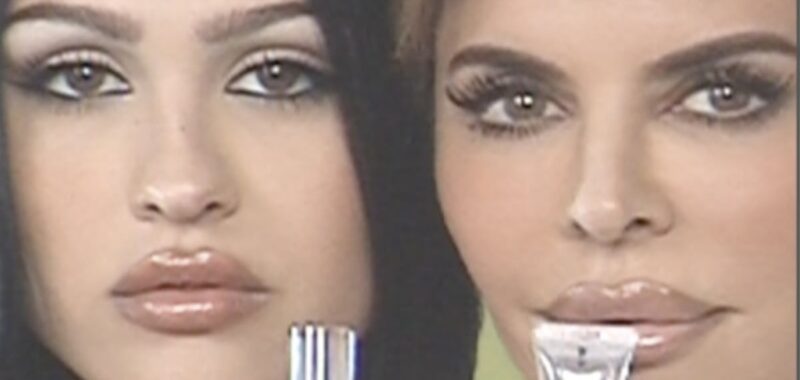
There was a time, not too long ago, when MAC Cosmetics was on everybodyâs lips.
The Estée Lauder Companies-owned brand, which celebrated its 40th anniversary last year, may have become associated with makeup artist quality cosmetics of all kinds, but its lip products were its first hits: Its signature lipsticks, smooth liners (especially in the signature shade Spice) and, come 2001, its sticky, high-shine gloss called Lipglass.
In the past few years, however, the area has been re-colonised by upstarts like Rhode and U-Beauty, which have released skin-caring formulas like a Peptide Lip Treatment or metal-tipped Lip Plasma. In the meantime, the OG MAC has lost some of its gloss and more of its gumption, which the brand desperately needs to win back.
On Wednesday, MAC introduces a new formula â a more wearable form of Lipglass, called Lipglass Air â and campaign dubbed âBorn Famousâ with a cast of so-called ânepo babies,â including budding content creators Zaya Wade and Francesca Scorsese, model Amelia Gray and her mother Lisa Rinna. A press release describes the formula, which soft launched in April, as âa new non-sticky gloss that shares the same name as her famous mother.â Itâs the brandâs latest effort to restoke its cultural flame.
âMAC, for a long time, was really thinking about makeup-artist first,â said Aïda Moudachirou-Rébois, MACâs general manager and senior vice-president, âand when weâre designing product today, we balance makeup artist and consumer.â
The brand continues to be a bright spot in ELCâs portfolio, bringing in north of $1 billion in annual revenue, but it has still been caught in the greater headwinds that have plagued the conglomerate.
The company faces softening demand (makeup net sales decreased 7 percent due to inventory issues that more than offset the gains from MACâs product innovation, according to its 2025 third quarter earnings) and lagging relevance with younger consumers. The next phase of its 2025 creative plan hopes to capture this cohort by reminding them of MACâs legacy in language they can understand.
Where the original Lipglass was a multipurpose gloss that provided a radiant but sticky finish, Lipglass Air is 7 percent oil, and provides a sheer, moisturising gloss in 10 shades. Unlike its motherâs paint-tube pack, Air is distilled into a mascara-sized thick plastic wand, and applies via doe-foot â resembling similar lip oils from the likes of Summer Fridays, Rare Beauty and others in the new guard.
The campaign will broadcast on social media, through shorts of Gray and Rinna clowning backstage; Wade doing a âshot clockâ of lip makeup application, in a nod to her father Dwayne; and Scorsese making a film-inspired skit, in a nod to her father Martin. There will also be out-of-home ads, shot by fashion photographer Sharna Osborne inspired by tabloids in the early 2000s, when Lipglass â and three of four of Airâs campaign stars â were born. âBorn Famousâ follows the brandâs January marketing experiment âI Only Wear MAC,â which assembled a triumvirate of Instagram baddies â Martha Stewart, Julia Fox and Tiffany âNew Yorkâ Pollard.
Rachel Green, a Dallas-based beauty consultant and – former Estée Lauder executive thinks the extension is timely, despite the brand being behind the curve on lip oils. âOver the past couple of years, lip products have exploded, but everybody goes back to Lipglass being iconic,â she said. âItâs honestly brilliant to do it in a more approachable format.â
But catering to a larger critical mass hasnât always resonated with MACâs core makeup artist community, some of whom saw the brandâs recent reformulation of its Studio Fix Powder Foundation to remove talc as turning its back on makeup artists, who were attached to the original formula.
âThe feedback was raging,â said Moudachirou-Rébois. But the truth was more complicated.
The reformulation was in response to an industry-wide shift away from talc, which has been linked to carcinogens like asbestos, restricted by jurisdictions from the EU to Japan and ailing conglomerates like Johnson and Johnson that relied on the ingredient for too long.
Itâs possible to wonder if, by formulating more user-friendly products, the brand is turning away from its namesake makeup artists collective. But Moudachirou-Rébois demurred as brand has always been âfor all ages, for all races, for everybody.â
MAC may be for everybody, but not everybody is buying it. The reality is that for MAC to succeed, is it has to be better and faster at recruiting customers and launching products to compete with other brands in market, from makeup artist-fronted lines like Makeup by Mario or Patrick Ta or artistry-infused labels such as Ami Colé.
Moudachirou-Rébois, noting that the brand is popular among Gen X and older Millennials, but has had a harder time capturing younger cohorts in the Western beauty market. MAC has had some wins, becoming the number one makeup label in emerging markets including Brazil, India, Turkey and Thailand.
Crucially, Green points out, the introduction of Lipglass Air isnât taking away the original from customers; in fact, the brand encourages them to mix and match their MACs, wearing Air with a liner, as Wade demonstrates, or beneath OG Lipglass, as is Rinnaâs preference.
âMAC is in the business of making money. Theyâve appealed to a young, makeup-loving consumer since the dawn of time,â Green said. âMakeup artists can get worked up about how MAC used to be for makeup artists. Well, no, â MAC is for everyone.â
Sign up to The Business of Beauty newsletter, your complimentary, must-read source for the dayâs most important beauty and wellness news and analysis.

